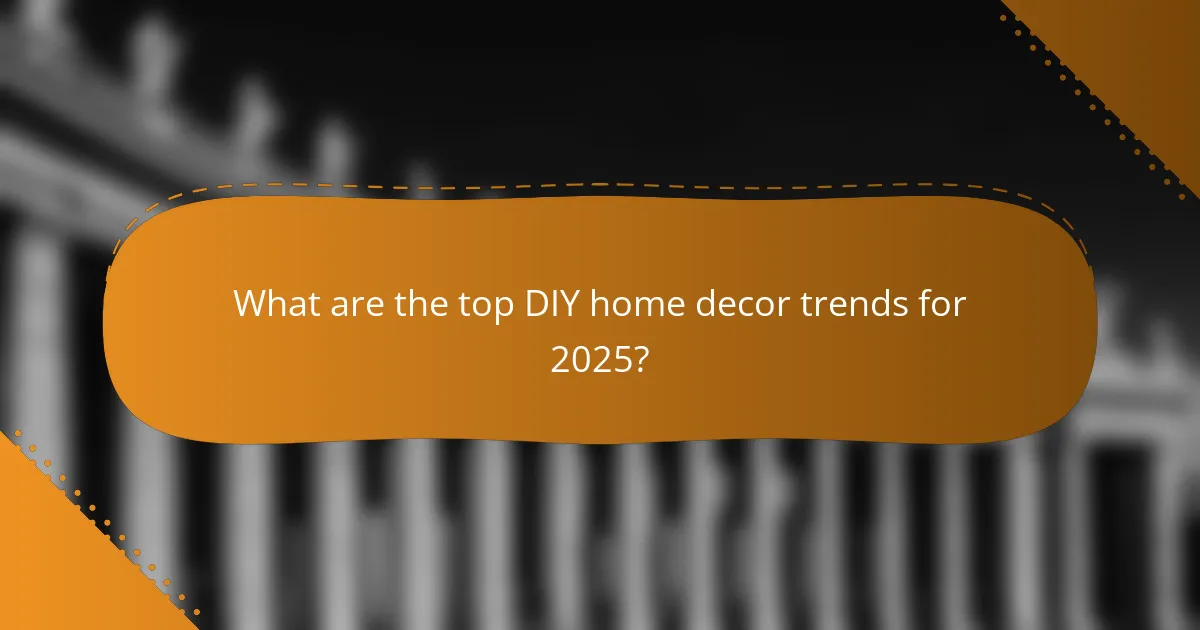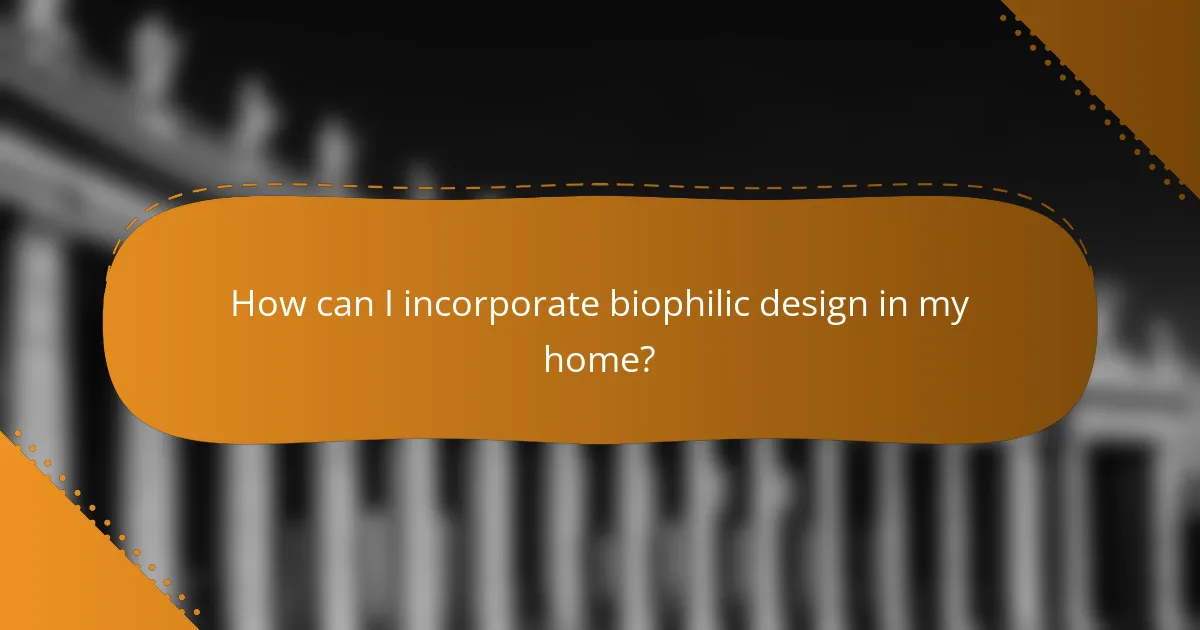As we look ahead to 2025, DIY home decor trends are set to prioritize well-being, functionality, and sustainability. Key highlights include the integration of biophilic design, vibrant color palettes, multifunctional furniture, upcycled materials, and smart home technology, all aimed at creating harmonious and efficient living spaces.

What are the top DIY home decor trends for 2025?
The top DIY home decor trends for 2025 focus on creating spaces that enhance well-being, functionality, and sustainability. Key trends include biophilic design, bold color palettes, multifunctional furniture, upcycled materials, and smart home integration.
Biophilic design elements
Biophilic design emphasizes the connection between nature and interior spaces, promoting well-being and tranquility. Incorporating elements like indoor plants, natural light, and organic materials can transform a home into a serene oasis.
To implement biophilic design, consider adding large houseplants, using natural wood finishes, or maximizing window space to allow more sunlight. Aim for a balance between indoor and outdoor elements to create a harmonious environment.
Bold color palettes
Bold color palettes are making a strong comeback in 2025, encouraging homeowners to express their personalities through vibrant hues. Rich colors like deep blues, emerald greens, and warm terracottas can create focal points and energize a space.
When selecting colors, consider using them in accent walls, furniture, or decor items. Pair bold colors with neutral tones to prevent overwhelming the space and to maintain a cohesive look.
Multifunctional furniture
Multifunctional furniture is essential for maximizing space, especially in smaller homes. Pieces that serve multiple purposes, such as sofa beds or storage ottomans, help create a more efficient living environment.
When choosing multifunctional items, look for quality craftsmanship and design that complements your style. This approach not only saves space but also adds versatility to your home decor.
Upcycled materials
Upcycled materials are gaining popularity as a sustainable choice for home decor. Repurposing old furniture or materials can add character and uniqueness to your space while reducing waste.
Consider DIY projects like turning wooden pallets into coffee tables or using reclaimed wood for shelving. This trend encourages creativity and resourcefulness, allowing you to craft personalized decor items.
Smart home integration
Smart home integration is becoming a standard feature in modern DIY decor, enhancing convenience and efficiency. Devices like smart lighting, thermostats, and security systems can be easily incorporated into your home design.
When integrating smart technology, prioritize compatibility and ease of use. Look for systems that can be controlled via smartphone apps or voice commands to streamline your daily routines and improve your living experience.

How can I incorporate biophilic design in my home?
Incorporating biophilic design in your home involves integrating natural elements to enhance well-being and connection to nature. This can be achieved through the use of indoor plants, optimizing natural light, and adding water features.
Indoor plants and greenery
Indoor plants are a fundamental aspect of biophilic design, as they improve air quality and create a calming atmosphere. Consider incorporating a variety of plants, such as ferns, succulents, or snake plants, which are generally low-maintenance and thrive indoors.
To maximize the benefits, place plants in areas where they can receive adequate light and be easily seen. Grouping plants together can create a lush, vibrant focal point in your space.
Natural light optimization
Optimizing natural light is crucial for enhancing the biophilic feel of your home. Use large windows, skylights, or glass doors to flood your space with sunlight, which can boost mood and productivity.
Consider using sheer curtains to diffuse harsh sunlight while still allowing light to enter. Reflective surfaces, such as mirrors, can also help distribute light throughout the room, making it feel more open and airy.
Water features
Water features, such as indoor fountains or aquariums, can introduce a soothing element to your home. The sound of flowing water can create a tranquil environment, reducing stress and promoting relaxation.
When adding a water feature, consider the size and maintenance requirements. Small tabletop fountains are easy to care for and can fit into various spaces, while larger installations may require more planning and upkeep.

What are the benefits of using bold color palettes?
Using bold color palettes in home decor can significantly enhance the aesthetic appeal and atmosphere of a space. These vibrant hues can create a lively environment, stimulate creativity, and make a strong design statement.
Enhanced mood and energy
Bold colors can positively influence mood and energy levels in a home. For example, shades of yellow and orange are often associated with happiness and warmth, making them ideal for kitchens or living areas. Incorporating these colors can invigorate a space and promote a sense of well-being.
When selecting bold colors, consider the natural light in the room. Bright colors can appear even more vibrant in well-lit spaces, while darker rooms may require lighter shades to avoid feeling cramped.
Personal expression
Bold color palettes allow homeowners to express their unique style and personality. Whether opting for a striking red accent wall or a mix of jewel tones in decor, these choices reflect individual tastes and preferences. This personalization can make a house feel more like a home.
To effectively use bold colors for personal expression, start with a neutral base and add vibrant accents through furniture, artwork, or accessories. This approach balances boldness with harmony, ensuring the space feels cohesive.
Visual impact
Bold colors create a strong visual impact that can transform a room. They draw attention and can highlight specific areas or features, such as architectural details or focal points. A well-placed splash of color can make a significant difference in the overall design.
When using bold colors, consider the scale and proportion of the space. Large areas may benefit from a single bold hue, while smaller spaces can use multiple colors in accents to avoid overwhelming the room. Aim for a balanced look by mixing bold colors with softer tones to maintain visual interest without chaos.

What multifunctional furniture options are trending?
Multifunctional furniture is increasingly popular for its ability to maximize space and enhance functionality in homes. Key trends include versatile pieces that serve multiple purposes, catering to the needs of modern living, especially in smaller spaces.
Sofa beds
Sofa beds are a staple in multifunctional furniture, providing both seating and sleeping options. They are ideal for accommodating guests without sacrificing space, making them perfect for apartments or smaller homes.
When choosing a sofa bed, consider the mattress quality and ease of conversion. Look for models that offer a comfortable sleeping surface and can be easily transformed from a sofa to a bed in a few simple steps.
Storage ottomans
Storage ottomans combine style and practicality by serving as both seating and storage solutions. They are perfect for keeping living spaces organized while adding a decorative element.
When selecting a storage ottoman, consider its size and the amount of storage it provides. Many models come in various materials and colors, allowing you to match them with your existing decor.
Expandable dining tables
Expandable dining tables are designed to adapt to different occasions, offering flexibility for both small family meals and larger gatherings. These tables can be extended or reduced in size, making them ideal for homes with limited dining space.
When choosing an expandable dining table, assess the mechanism for extension and the overall stability when expanded. Look for tables that can comfortably seat additional guests without compromising on style or space efficiency.

How can I effectively upcycle materials for decor?
Upcycling materials for decor involves creatively reusing items that would otherwise be discarded, transforming them into functional or aesthetic pieces. This practice not only reduces waste but also adds a unique touch to your home.
Repurposing old furniture
Repurposing old furniture can breathe new life into your living space. Consider painting a worn-out dresser to use as a TV stand or converting an old door into a stylish coffee table. Simple modifications like adding new hardware or changing upholstery can make a significant difference.
Before starting, assess the condition of the furniture. Ensure it is structurally sound and free from pests. A little creativity can turn a discarded piece into a focal point in your home.
Using reclaimed wood
Using reclaimed wood is a sustainable choice that adds character to your decor. Look for sources like old pallets, barn wood, or salvaged beams to create items such as shelves, tables, or accent walls. This wood often has a unique patina and history that new materials lack.
When working with reclaimed wood, check for any treatments or chemicals that may have been used. Sanding and sealing the wood can enhance its appearance and durability, making it suitable for indoor use.
Creating art from scrap materials
Creating art from scrap materials is an innovative way to express your creativity while reducing waste. Gather items like fabric scraps, bottle caps, or old magazines to craft wall art, sculptures, or decorative pieces. This approach allows for endless possibilities and personal expression.
Start by brainstorming ideas and sketching designs. Use strong adhesives and consider safety when handling sharp or heavy materials. Display your creations prominently to showcase your unique style and commitment to sustainability.

What smart home technologies are popular in decor?
Smart home technologies are increasingly integrated into home decor, enhancing both functionality and aesthetics. Popular options include smart lighting, smart thermostats, and voice-activated assistants, which allow for seamless control and customization of living spaces.
Smart Lighting Solutions
Smart lighting systems enable homeowners to control brightness, color, and scheduling through mobile apps or voice commands. Options range from LED bulbs that can change colors to entire systems that sync with music or movies, creating immersive environments.
Consider using smart bulbs that fit standard fixtures for easy upgrades. Brands like Philips Hue and LIFX offer products that can be controlled remotely, allowing you to set moods or automate lighting based on your daily routine.
Smart Thermostats
Smart thermostats learn your heating and cooling preferences, optimizing energy use while maintaining comfort. These devices can be programmed or adjusted remotely, helping to reduce energy bills by managing usage during peak hours.
Popular models like the Nest Learning Thermostat or Ecobee SmartThermostat can save homeowners significant amounts on energy costs, often recouping their initial investment within a year or two.
Voice-Activated Assistants
Voice-activated assistants, such as Amazon Alexa or Google Assistant, serve as central hubs for controlling various smart devices in your home. They can manage lighting, temperature, and even entertainment systems through simple voice commands.
Integrating these assistants into your decor can streamline daily tasks and enhance convenience. Ensure compatibility with your existing smart devices to maximize functionality and create a cohesive smart home ecosystem.


